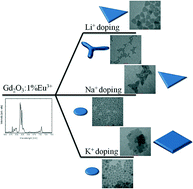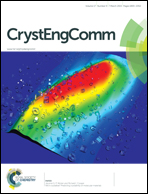Controlled synthesis of luminescent Gd2O3:Eu3+ nanoparticles by alkali ion doping†
Abstract
The influence of mono-positive alkali ions (Li+, Na+ and K+) on the growth processes, crystal structure and spectroscopic properties of Gd2O3 colloidal nanoparticles doped with Eu3+ ions was investigated. The size of an alkali dopant ionic radius, with respect to that of Gd3+ ions, and the relative concentrations of the alkali ions against that of Gd3+ were found to have a significant impact on the morphology of the obtained Gd2O3 nanoparticles which could be tuned from ~10 nm nanospheres, through ~40 nm nanotripods and nanotriangles, leading to over 50 nm sized, square-like shaped nanoparticles. The observed evolution of the Gd2O3 crystal structure upon alkali ion doping allowed finding of the maxima of the impurity ion concentration inside the Gd2O3 crystal lattice. The distortion of the crystal structure of Gd2O3 introduced by Li+, Na+ or K+ doping was also related to the ratio of electric to magnetic dipole transitions in Eu3+ ions, the shape of the 5D0 → 7F0 transition, and the 5D0 energy level luminescence lifetime values. The obtained results show the possibility of using intentional impurities to tune the morphology of colloidal Gd2O3 NPs, and simultaneously of using the luminescence of Eu3+ ions for sensing the changes in local surroundings.


 Please wait while we load your content...
Please wait while we load your content...